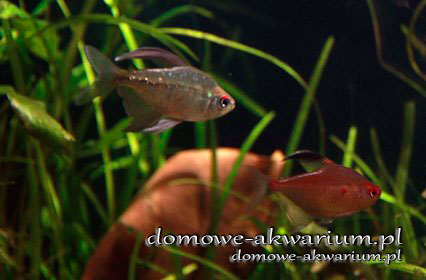
| Species | Diamond Tetra |
|---|---|
| Latin Name | Moenkhausia Pittieri |
| Family | pike-perches |
| Origin | Ameryka Południowa |
| Length | 6 cm |
| Temperature | 24 - 28°C |
| Water Hardness | soft - medium hard |
| pH | 5.5 - 7.0 |
| Aquarium Size | 60 L |
| Food | any: dry, frozen, live |
Diamond Tetra
A freshwater species, endemic to Lake Valencia in Venezuela. Its habitats are shallow, densely overgrown standing waters and slowly flowing tributaries of the lake.
Pittier's hatchetfish is characterized by a high body habitus, strongly laterally compressed. Its color is olive-gray with a golden sheen. A narrow, dark stripe is faintly visible along the lateral line. The iris of the eye is red in the upper part – Red. Fins are transparent-purple. The tail fin – forked. Males are larger and more brightly colored than females. Additionally, they have longer ventral, dorsal, and anal fins.
This is a peaceful, active, and social species that will get along well with livebearers, danios, razorfish, neons, other tetras, cory catfish, small species of plecos, dwarf gouramis, and cichlids. We just remember to make sure the companions are of similar size. Occasionally, this fish attacks the fins of other species. However, this behavior is eliminated completely when it is kept in a larger group of its own species – a minimum of 6 individuals. Then all negative behaviors are contained within the group. The group also promotes stronger coloring of males. A hardy species that may nibble on plants. It's quite voracious and likes to chase other fish during feeding. It can be recommended to beginner aquarists.
This is a flexible species that will thrive in any aquarium (sociable, Amazon biotope, planted). Keep in mind that this fish does not favor too bright lighting (floating plants will be helpful) and the aquarium should be longer than it is taller. Pitter's hatchetfish looks best in densely planted tanks with free swimming spaces, dark and fine substrate, twisted roots. Regular partial water changes are essential – about 20% every 2 weeks.

A species laying eggs. We should breed fish in a separate tank with dimmed lighting, plants with small and soft leaves, with soft water, a pH of 5.5-6.5, and a temperature of 27-29°C. Fish should breed in groups or in pairs, and we can stimulate them to spawn by feeding them more live food. When we breed fish in pairs, we should separate males and females beforehand. After a few weeks, in the evening, we move the fattest female and the most colorful male to the breeding aquarium. Spawning should take place the next day, in the morning hours. The female lays eggs in the open water column, which fall to the bottom or stick to plants. After the deed is done, we remove the parents - they do not take care of the eggs or the fry, but they participate in consumption with great pleasure. Larvae hatch after 1-1.5 days. The fry swim freely in search of food 3-4 days later.